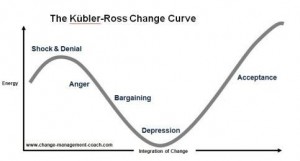This article is based on the 5-Stage model originally proposed by author Elisabeth Kubler-Ross
 Any kind of change involves the loss of something: status quo, possessions, relationships, etc. The 5-Stage model suggested by Elisabeth Kubler-Ross in a book related to loss of life (an extreme form of loss) has been also used to explain how people react to change…
Any kind of change involves the loss of something: status quo, possessions, relationships, etc. The 5-Stage model suggested by Elisabeth Kubler-Ross in a book related to loss of life (an extreme form of loss) has been also used to explain how people react to change…
These 5 stages represent the kinds of feelings people experience when dealing with significant change in their own lives or in the workplace. The stages represent the coping mechanisms that human beings need to navigate through the difficult experience of significant change or loss.
The stages do not occur in a linear, one-after-another fashion. Someone can be in multiple stages simultaneously, get past a stage and then slip back. Not everyone gets through all stages. For example, someone could just get bogged down in Stage 3 and never go beyond that.
However, there is a discernible trend progressing from Stage 1 to Stage 5. The stages are as follows:
Stage 1 – Shock or Denial
The typical reaction here is “Oh no! This can’t be happening to me!” Denial is often a defense mechanism that allows time to absorb news of change. This is the stage where we don’t believe the change is happening.
Stage 2 – Anger
The typical reaction here is “This is just not fair and I won’t accept it!” As soon as people realize that the change (or loss) is real, denial gives way to anger and sometime rage.
Stage 3 – Bargaining
The typical reaction here is “Why don’t you make the change in finance first – leave sales alone at this time please.” This is basically an attempt to find a way out or delay the inevitable.
Stage 4 – Depression
The typical reaction here is “I give up! What’s the point?” This is when people realize there is no way out and the inevitability of the change or potential loss hits home. In the workplace, this stage is where people get unmotivated and resentful.
Stage 5 – Acceptance
The typical reaction here is “This is not going away so I might as well face it”. As soon as people realize that denying the change is not working and it is here to stay, they start to accept. Acceptance is quickly followed by an exploration of possible options and strategies to embrace the change.
Some people will reach this stage of acceptance quickly. Others can take a long time and some may never reach this stage.
The Kubler-Ross Change Curve described in this article is one of the most reliable tools to understand change. It can be effectively used by business leaders to help their workforce adapt to change and move towards success.
For a detailed, actionable and practical guide to the Kubler-Ross Change Curve that covers 1) what is Kubler-Ross Model, 2) the applications of the Kubler-Ross Change Curve, and 3) variations of change curve concepts, please visit this site

Leave a Reply